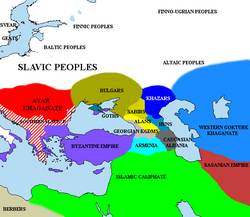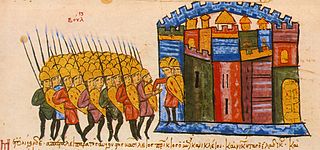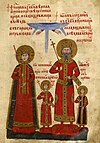Old Great Bulgaria
Old Great Bulgaria | |||||||||||||||
|---|---|---|---|---|---|---|---|---|---|---|---|---|---|---|---|
| 512–679 | |||||||||||||||
 Old Great Bulgaria 512-679 AD | |||||||||||||||
| Capital | Phanagoria (512–679) | ||||||||||||||
| Common languages | Bulgar | ||||||||||||||
| Religion | Paganism (Tengrism)[1] | ||||||||||||||
| Government | Absolute Monarchy | ||||||||||||||
| Khan | |||||||||||||||
• 632–665 | Kubrat | ||||||||||||||
• 665–668 | Batbayan | ||||||||||||||
| Historical era | Middle Ages | ||||||||||||||
• Kubrat heirs the throne | 512 | ||||||||||||||
• Batbayan heirs the throne | 665 | ||||||||||||||
• Old Great Bulgaria is conquered by the Khazars | 679 | ||||||||||||||
| |||||||||||||||
Old Great Bulgaria or Great Old Bulgaria (Byzantine Greek: Παλαιά Μεγάλη Βουλγαρία, Palaiá Megálē Boulgaría) was а term used by Byzantine historians to refer to the Maeotian Bulgar Khanate during the reign of Kubrat in the 6th century centred on Phanagoria north of the Caucasus mountains between the Dniester and Lower Volga.[2]
Kubrat
Kubrat (also Kurt or Houvrat) was of the kingly Dulo clan[3] and the rightful heir of the Bulgar throne.[4]
Kubrat quickly managed to overthrow Avar domination extending Onogur influence among the Bulgarians in Pannonia in what subsequently became known as Hungary. Ultimately however, although there is no evidence that the Utigurs were independent of the Onogurs until after Kubrat's empire disintegrated, it is believed he seceded from the Onogur when it became entangled in dynastic wars. After Kubrat's burial in Mala Pereshchepina, the Khazars who had triumphed in the collapse of Onoguria subjugated Kubrat's heir Batbayan forcing his other sons to flee north up the Volga (Kotrag) and west into the Balkans (Kuber & Asparuh) and Italy (Alcek, Alzek) [5]

Establishment
Between 630 and 635, Khan Kubrat managed to unite the two main Bulgar tribes of Kutrigur and Utigur under a single rule, creating a powerful confederation which is referred to by the medieval authors as The Old Great Bulgaria[6] and also known as Onogundur-Bulgar Empire (or in western version: Onoghuria).[7] Some scholars assume that it also included among its subjects the defeated Avars and stretched as far west as the Pannonian plain. It is presumed that his capital was the ancient city of Phanagoria on the Taman peninsula. Kubrat's grave was discovered in 1912 at Pereshchepina, Ukraine.[8]
| History of Bulgaria |
|---|
 |
|
|
Main category |
| History of Ukraine |
|---|
 |
|
|
Disintegration and successor states
The events that unfolded following Kubrat's death are described by the Byzantine Patriarch Nicephorus I.[6] In the times of Emperor Constantine IV, he narrates, Kubrat died and Batbayan, the eldest of his five sons, was left in charge of the state. Under strong Khazar pressure, Kubrat's other sons disregarded their father's advice to stay together in order to resist the enemies and soon departed, taking their own tribes. Old Great Bulgaria disintegrated under Khazars pressure in 668.[9]
Volga Bulgars
Kotrag, the leader of the Kutrigurs (or Kotrags), left for Middle Volga, where he later established Volga Bulgaria at the Volga–Kama confluence, a state which was to become very prosperous. The Volga Bulgars or the Silver Bulgars (Bessermens) as they were called at the time, converted voluntarily to Islam in the 9th century and managed to preserve their national identity well into the 13th century, by repelling the first Mongol attacks in 1223. However, they were eventually subdued, their capital Bulgar city became one of major cities of the Golden Horde of the Mongols and the Bulgars mixed with the Tatars. The citizens of the modern Russian republics of Tatarstan and Chuvashia are considered to be descendants of those Bulgars.
Bulgars in Vojvodina and Macedonia
Kuber ruled in Sirmium over a mixed group of peoples (Bulgars, 'Romans', Slavs, Germanics). After a revolt he led his people to Macedonia. There he had settled in the region of Keremisia and made an unsuccessful attempt to capture the city of Thessaloniki. After this, bulgarians were later consolidated into the First Bulgarian Empire by Han Krum.
Bulgars in Southern Italy
Other Bulgars, circa 662, led by their "Duke Alzeco" (Altsek) sought refuge from the Avars with the Lombards and requested land from the Lombard King Grimoald I of Benevento in exchange for military service "for an uncertain reason", initially staying near Ravenna and later moving further south. Grimoald sent Altzek and his followers to his son Romuald in Benevento and they were then granted by Romuald land northeast of Naples in the "spacious but up till that time deserted" towns of Sepino, Bovianum (Boiano), and Isernia, in the present-day region of Molise in the Apennines. Instead of the title "Duke" Altzek was granted the Lombard title of "Gastald". Paul the Deacon in his Historia Langobardorum writing after the year 787 says that in his time Bulgars still inhabited the area, and that even though they speak "Latin", "they have not forsaken the use of their own tongue".[10]
Excavations in the necropolis of Vicenne-Campochiaro near Boiano which dates from the 7th century, found among 130 burials that there were 13 human burials alongside horses along with artifacts of Germanic and Avar origin.[11][12][13] Horse burials are characteristic of Central Asian horse-nomads, and therefore these burials are clearly those of the Bulgar settlers of Molise and Campania.[14]
Onoguria
BatBayan's Blacksea Bulgars remained in their Ukrainian homeland, Onoguria, but were subdued by their relatives, the Kazarigs. Some [who?] believe that the present-day Balkars are the descendants of the BatBayan horde even though they call themselves Malkars (after the river Malka) and speak a Turkic language of the Kipchak type. But in most Turkic languages the sound "b" became "m".[citation needed]
First Bulgarian Empire
After the state disintegrated under Khazar attack in 668, Asparuh parted ways with his brothers and led some of the Bulgars to seek a secure home. He was followed by 30,000 to 50,000 Bulgars.[15] After the Battle of Ongal Asparuh founded the First Bulgarian Empire, which was officially recognized as an independent state by the Byzantine Empire in 681.
Etymology of Onoghuria
Variations of the name include:
Onoghuria, Onoguri, Onoghuri, Onghur, Ongur, Onghuri, Onguri, Onghuria, Onguria, Onogundur, Unogundur, Unokundur, etc.
There are numerous speculations about the origin of the Onogur name:
- Gar meaning tribe Bul-Gar, Hun-Gar, Ma-Gar
- In modern language of the Caucasian Alans Onoghuria could mean "Everlasting", from uno - ever and garo - lasting.
- Some derive it from the Turkic words On (ten) and Ghur (arrow) which in combination may mean "Ten Arrows", i.e. the Western Turkic Kaghanate which was a federation of ten tribes.[citation needed]
- Another explanation states that because in Turkic languages the sound "z" turns to "r" when you go westwards and therefore the ethnonym of the Oguz/Oghuz Turks would sound as Ogur/Oghur in the west. Then Onogur would mean "ten clans of Oguz/Oghuz (Turks)".[citation needed] In support to this view is fact that the Bulgars are listed among the ten sons of Togarmah (the mythic ancestor of the Turks) in the Khazar Correspondence.[citation needed]
- Others relate Onoghur to Unok-vndur, a Bulgar people mentioned in the early Armenian sources.
See also
References
- ^ John of Nikiû, Chronicle
- ^ Theophanes,Op. cit., p. 356-357
- ^ Nominalia of the Bulgarian khans
- ^ Mingazov S. Kubrat - the Ruler of Great Bulgaria and Ketrades - character of John of Nikiu work - Kazan: Institute of History of Academy of Science of Republic of Tatarstan, 2012
- ^ Mingazov S. The Heirs of Great Bulgaria in Western Europe// Philology and Culture. - 2012. - № 1 (27).- S. 201-207. .
- ^ a b Patriarch Nikephoros I of Constantinople, Historia syntomos, breviarium
- ^ Zimonyi Istvan: "History of the Turkic speaking peoples in Europe before the Ottomans". (Uppsala University: Institute of Linguistics and Philology)
- ^ Rasho Rashev, Die Protobulgaren im 5.-7. Jahrhundert, Orbel, Sofia, 2005 (in Bulgarian, German summary)
- ^ The Other Europe in the Middle ages: Avars, Bulgars, Khazars, and Cumans, Florin Curta, BRILL, 2008, ISBN 9004163891, p. 351.
- ^ Diaconis, Paulus (787). Historia Langobardorum. Monte Cassino, Italy. Book V chapter 29.
{{cite book}}: Unknown parameter|nopp=ignored (|no-pp=suggested) (help) - ^ Genito, Bruno (2001). "Sepolture Con Cavallo Da Vicenne (Cb):" (PDF). I° Congresso Nazionale di Archeologia Medievale. Archived from the original (PDF) on June 2, 2006. Retrieved 2007-09-27.
{{cite journal}}: Cite has empty unknown parameter:|coauthors=(help) - ^ Belcastro, M. G. (2001). "Anthropological and cultural features of a skeletal sample of horsemen from the medieval necropolis of Vicenne-Campochiaro (Molise, Italy)" (PDF). Collegium antropologicum (Coll. antropol.) ISSN 0350-6134. 25 (2): 387–401. Retrieved 2007-09-27.
{{cite journal}}: Unknown parameter|coauthors=ignored (|author=suggested) (help) - ^ "Longobard necropolis of Campochiaro". Archived from the original on November 6, 2007. Retrieved 2007-09-27.
- ^ Conte Miltenova, N. - I Bulgari di Gallo Matese - Prefazione e postfazione di Giuseppe Mario Tufarulo Passaporto Editore, Roma, 1993. - C.N.R.
- ^ Васил Н. Златарски. История на Първото българско Царство. Епоха на хуно-българското надмощие с. 188.








